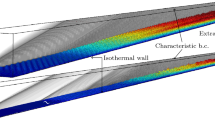Abstract
We consider a laminar boundary layer for which the stagnation enthalpy specified in the initial section is variable with height. Such problems arise, for example, for bodies located in the wake behind another body, for hypersonic flow past slender blunted bodies (as a result of the large transverse entropy gradients in the highentropy layer), for stepwise variation of the temperature of a surface on which there is an already developed boundary layer, for sudden expansion of the boundary layer as a result of its flow past a corner of the surface, etc.
Strictly, we should in such cases solve the boundary layer equations (if the longitudinal gradients are much smaller than the transverse) with the specified initial distribution of the quantities. However, from the physical point of view, the distributed region may be broken down into two regions, the near-wall boundary layer and an outer region which is a gas flow with constant velocity and the specified initial temperature profile, whose calculation yields the edge conditions for the boundary layer. The boundary between the regions is determined from the condition of adequately smooth matching of the solutions. This approach is much preferable to the first, since it permits avoiding (within the framework of boundary layer theory) the difficulties associated with the presence of a possible singularity at the initial point of the surface due to the discontinuity of the boundary conditions at this point, and also permits using conventional boundary layer theory if the effect of the viscosity in the outer region is not significant. However, this partition requires additional justifications of the possibility of independent determination of the solution in the outer region and the determination of the edge of the boundary layer, considered as the region of influence of the wetted surface. The boundary layer in a nonuniform flow has been considered in several works for a linear initial velocity or temperature profile [1–3].
It should be noted that the linear initial enthalpy or velocity profiles for constant gas properties do not undergo changes under the influence of viscosity or thermal conductivity. Thus the fundamental characteristic features noted above which are associated with the presence of the two regions and their interaction in essence cannot be investigated using these examples.
In this study we obtain and analyze the exact solutions of the equations of the compressible boundary layer for a power-law variation of the initial stagnation enthalpy profile as a function of the stream function for a constant initial velocity. Here it is shown that the influence of the boundary conditions at the wall are actually localized in the near-wall boundary layer, which is similar in dimensions to the conventional velocity or thermal boundary layers. In the region which is external with relation to this layer, in accordance with the physical picture described above, the solution coincides with the solution of the Cauchy problem for the heat conduction equation, which describes the development of the initial temperature profile in an infinite steady-state flow with constant velocity.
It is shown that for the sufficiently smooth initial profiles which are of interest in practice the outer flow undergoes practically no changes until we reach the inner boundary layer, and it may be calculated using the perfect gas laws.
Similar content being viewed by others
References
Ting Yi Li, “Effects of free-stream vorticity on the behavior of a viscous boundary layer”, JAS, vol. 23, no. 12, pp. 1128, 1129, 1956.
M. B. Glauert, “The boundary layer in simple shear flow past a flat plate”, JAS, vol. 24, no. 11, pp. 848–849, 1957.
E. M. Sparrow and J. L. Gregg, “The effect of a nonisothermal free stream on boundary-layer heat transfer”, JAM, no. 2, pp. 161–165, 1959.
D. Chapman and M. Rubesin, “Temperature and velocity profiles in a laminar boundary layer of compressible gas with arbitrary temperature distribution along the body surface”, collection: Mechanics [Russian translation], no. 4, 1950.
Author information
Authors and Affiliations
Rights and permissions
About this article
Cite this article
Lunev, V.V., Rumynskii, A.N. Boundary layer development in a gas flow with stagnation enthalpy varying across the streamlines. Fluid Dyn 1, 20–24 (1966). https://doi.org/10.1007/BF01022144
Issue Date:
DOI: https://doi.org/10.1007/BF01022144




